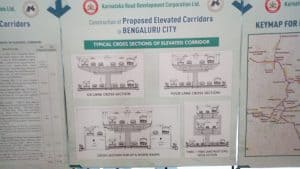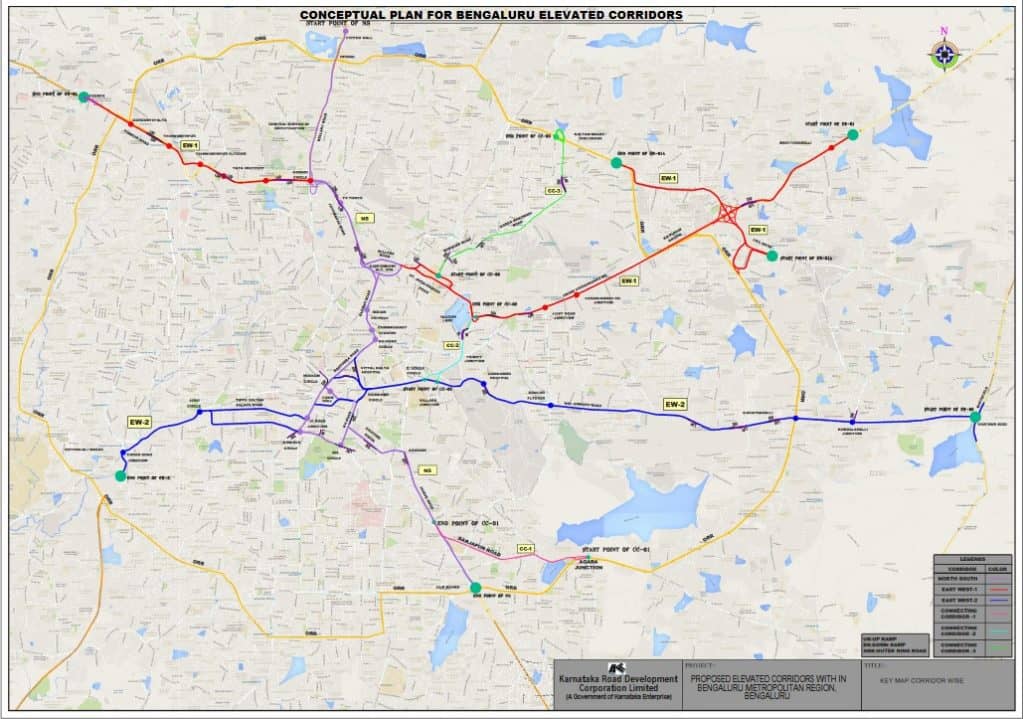I was pretty excited and went with a lot of hope to attend a ‘Namma Karnataka’ development conclave at Vidhana Soudha on February 17, jointly organised by a media house and Government of Karnataka. The event, however, turned out to be a major marketing and propaganda exercise of government’s infamous Elevated Road Corridor Project. Large flex banners highlighting the project had been put up at the venue, and the panel discussion on Bengaluru’s transport issues hardly had any discussion, and there was no question and answer session.
Since I and many other invitees did not get an opportunity to voice our opinions and technical viewpoints, I decided to write this article to provide some technical perspective on such massive road infrastructure projects being proposed by the state government to solve traffic congestion problems and related externalities.
First of all, the basic premise of the state government on effective utilisation of road space, and its justification for pushing such road projects, is fundamentally flawed. Their focus is on vehicle capacity (in terms of Passenger Car Units (PCU) per hour) rather than person capacity (in terms of passengers per hour, per direction).

Where is the space to add more buses in Bengaluru. Yet, we add almost 3,000 new personal vehicle registrations every day?
Time and again the question raised is, where is the space to add more buses in Bengaluru. Yet, we add almost 3,000 new personal vehicle registrations every day for which we apparently have space. In fact, a bus needs the same lane width to move as a car, and has a much higher person capacity (8.3 times where there is a bus priority lane). While a metro rail system provides 38 times more carrying capacity with the same Right-of-Way (ROW) width provided for normal traffic.
Using a macro-simulation travel demand model that IISc’s Transportation Engineering Research Lab developed for the whole Bengaluru Metropolitan Region (BMR), we did an estimation of how much space cars and buses currently occupy on BMR’s road network at any moment during typical peak hour travel. As per our model, the total area occupied by cars, which carry only about 5 per cent trip mode share, during peak hours is 2137 times the area occupied by buses, which carry 45 per cent trip mode share. (Trip Mode share means the percentage of trips by cars (or buses) to the total number of trips. Src)
To carry one person, a car occupies 12.8 times more space than a bus.
If we convert this to space that a car occupies on the BMR road network to carry one person, the result is a shocking 12.8 times more space than a bus. At the same time, a two-wheeler occupies 1.8 times more space than the space required for a person sit in a bus. That is, the road space required for two-wheelers to carry the same number of passengers in a bus is the 1.8 times more than the space required for a bus. Considering these statistics, how can the government continue to justify huge investments for such low capacity, cost intensive projects like elevated road corridor?
Public transport in Bengaluru should have 70% modal share compared to 50-55% currently!
For an Indian city of one crore population like Bengaluru, the ideal modal shares for a sustainable transport system should be 70 per cent for all public transport modes (currently about 50-55 per cent) and at least 15-20 per cent for bicycling and walking. Costly road-based projects will only result in the opposite of this ideal mode share that the city should have.
My research lab also simulated the impact of the proposed elevated road corridor on normal traffic in the whole BMR network and on the likely changes in exhaust emissions and fossil fuel consumption, comparing it with a simulated of metro rail system scenario running on the same elevated corridor (besides the phase-1 and committed phase-2 of Namma Metro).
Simulation shows fuel consumption will decrease by 5-7 % if we have metro in this corridor instead of elevated roads.
Results from the simulation estimated that compared to the present Business as Usual (BAU) scenario, total fossil fuel consumption in BMR will increase by 3-4 per cent in the elevated road corridor scenario whereas it will decrease by 5-7 per cent in the metro rail scenario. Similarly, the elevated rail corridor will increase exhaust emissions of pollutants like CO, HC, NOx, CO2 and PM by 3-4 per cent while a metro on the same corridor will reduce exhaust emissions by 5-6 per cent.
Also, while the elevated road corridor will reduce total system travel time by 8 per cent, the metro scenario will reduce travel time by 40 per cent. Moreover, at critical locations along the corridor like K R Puram junction, the volume to capacity ratio (V/C) on the elevated road corridor would exceed 2.0 (being large and long conduits it will suck traffic from across the network) and just a little less than 1.0 below it at ground level, while a metro rail would have a V/C ratio substantially below 1.0 even on the ground level road.
In a nutshell, the elevated corridor will only decrease the sustainability of the transport system and overall liveability of the city whereas a mass rapid public transport scenario like a metro on the same corridor will help the city achieve the right modal share balance and a reduction in transport related externalities.
The government should stop trying to satisfy users of all the modes all the time, and aim to achieve a right balance of trip mode share to improve the overall quality of life of Bengaluru.

Very good article by highly qualified person in the subject ,it is high time our govt to listen to such persons before going into unwanted mega projects
BMTC SHOULD seriously change 80 % of their fleet to double decker Buses.. this will create space for all and carry more ppl (less standies).. cost will also be less
Very Well studied and written.
Hats-off.
Government is short term and so is their vision
Having a complete Peripheral Ring Road will reduce much more traffic along ORR & within the city or CBD..
Definitely, just by adding public transport people will not abandon their cars, public transport will always lack last mile connectivity and not everyone wants the hassle of changing metro to bus to another bus then walk home, the public transport system can compliment the current road network but our road infrastructure desperately needs expansions and projects such as the PRR.
3000 new personal vehicles every day? The government seems to be more concerned about their road tax revenue than pollution and congestion. It is a pity that the political leadership in Karnataka lacks long term vision.
Well written. The simulation technique is always good. It would be good to view all the comparative results using tables/charts. Adding additional parameters like beneficiary agencies etc., may give govt’s hidden agenda what they always look for to justify their action.
BMRCL metro organisation has very poor delivery record . That’s the real issue. They make five year plans which means they have no clue about when they can deliver. The metro route planning iindicates they have no understanding of Bangalore needs. Roads are with buses, it gets done fast and is usable by everyone.
Government has a conflict of interest since they depend on the road tax and taxes on petrol/diesel to earn revenue. More efficient modes of transport (whether buses or metro or local trains) will put a hole in government’s revenue generation. It should be on citizens to fight the battle and push the government to scrap the elevated road corridor project and focus on improving the local trains and metros and buses.
Is govt different entity. It’s run by people demands not on politicians money making demands.
This is an excellent article Sir , govt has no vision or pubic interest to care for . let us all the people of Bangalore city come on streets to stop it . Without public support v cannot stop anti-people projects .